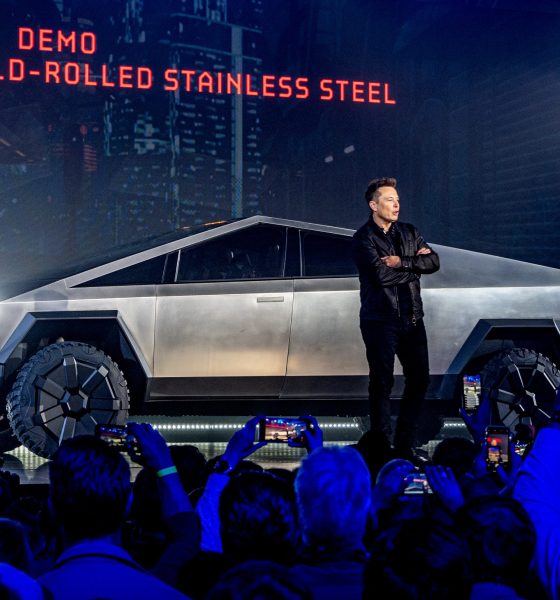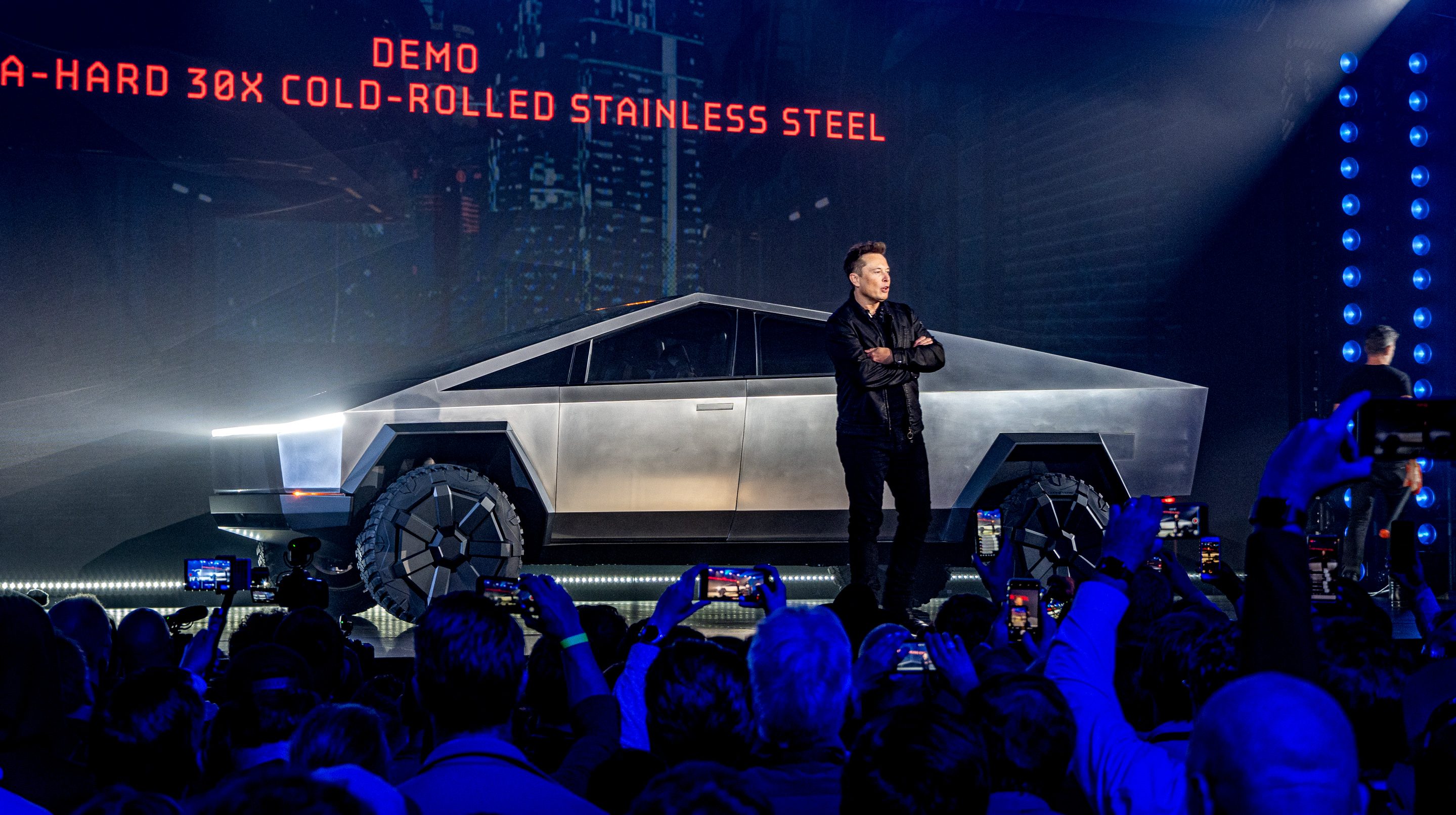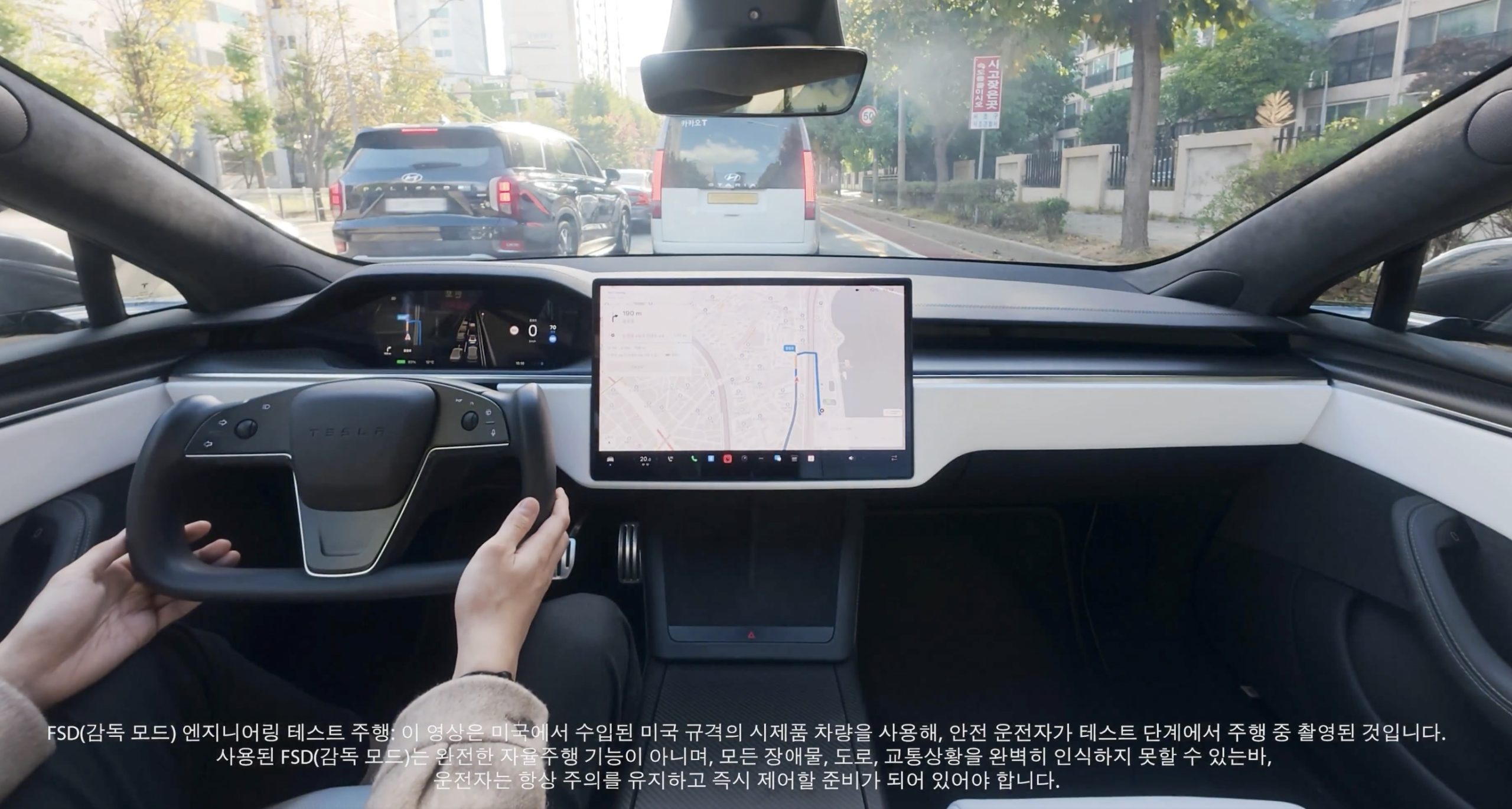

News
Why Tesla can’t ditch the Cybertruck for a traditional pickup design
The Tesla Cybertruck is so “Tesla,” it’s not even debatable. To me, at least. The truck is the true embodiment of everything the electric automaker had stood for during the last seventeen years when it was established in 2003. It breaks all the rules; it goes against the look and feel of “traditional” automotive manufacturing. It is a rebellious statement against the normal boundaries of what a truck is “supposed” to be. Making a traditional, typical, and standard pickup truck would break all of Tesla’s rules, and if the company ends up designing it, it would mean that the legacy automakers have won.
Earlier this week, CEO Elon Musk said that if the Cybertruck happens to tank in sales, Tesla will end up designing a more traditional pickup for the market to consider. Even though I openly said I don’t think that Tesla will have to worry about designing and manufacturing a Cybertruck alternative, the possibility still worries me.
I know what many of you are probably thinking. “Joey, that’s really extreme.” Or, maybe, “Joey, that’s ridiculous, Tesla is just doing what it can to stay competitive in a popular market in case the Cybertruck tanks.”
Sure, I can agree with the second one from an economic standpoint for the company, but I certainly don’t see my point of view as extreme.

Tesla’s Cybertruck, when it was unveiled, shocked the world. It made everyone question what the company was doing. I’ll admit, when I saw that beast roll out onto the stage in Hawthorne, California, I was skeptical. I think I said something along the lines of, “What the hell is that thing?”
But as the presentation went on, I found myself increasingly interested in what Tesla was doing. I realized it was meant to be ridiculous, different, and “polarizing,” as so many people like to call it. It made the entire automotive industry look at the company, and it has worked thus far because it is arguably the most talked-about vehicle in recent memory.
Let’s be honest: Tesla has always broken the rules. Skeptics said the Model S would fail. It didn’t. They said Tesla couldn’t attain a considerable or acceptable range for its EVs. The company did and has scrapped vehicle models that aren’t capable of “acceptable range” of over 250 miles. They said the company couldn’t make an affordable vehicle. The Model 3 and Model Y are both mass-market cars geared toward affordability. They said Tesla couldn’t turn a profit. It just did, for the fourth consecutive quarter.
Tesla has always done what people said wasn’t possible. The Cybertruck is just one of the latest examples.
When the Cybertruck was unveiled, people said, “Nobody will buy that.” “It’s ugly.” “Even if people buy it, it won’t perform well against petrol-powered pickups.”
It has a substantial amount of pre-orders. According to CybertruckOwnersClub’s reservation number decoder, it has over 750,000 pre-orders.
It may be ugly to some, but that’s an opinion and subjective. I find the truck unique and beautiful in its own way.
The Cybertruck won a Tug-of-War against an F-150.
There are those three theories debunked.
This is a preview from our weekly newsletter. Each week I go ‘Beyond the News’ and handcraft a special edition that includes my thoughts on the biggest stories, why it matters, and how it could impact the future.
A big thanks to our long-time supporters and new subscribers! Thank you.
But more significant than that, the Cybertruck is really an embodiment of Tesla’s mission as a whole. It has always been to prove the doubters wrong, to change the way people look at cars. Before Tesla, people saw their everyday drivers as a way to get from Point A to Point B. Some were faster than others, some were louder than others, and some had better stereos than others. The point is, when Tesla’s came out, their vehicles became more than a daily transportation outlet. They became entertainment machines, and they changed the way the world looked at a car.
The Cybertruck did the same thing. It changed the way people looked at trucks, even though nobody has one yet. It is a summarization of what Tesla has always meant and tried to convey to people. Change the way people look at something, and the possibilities become limitless. Before the Cybertruck, people thought that the “truck” had to have a cab, a bed, and look nearly the same as every other pickup on the market. But that’s the thing. Tesla has never used the rules or the “typical” idea for anything. That’s what makes Tesla, Tesla.
People knew battery-powered cars were possible, but nobody was good at it. The other car companies in the world were too focused on making their petrol engines more advanced at the time. After all, nobody was anxious about climate change at the time. At least, it wasn’t widely accepted by people until the mid-2000s from what I remember.
Tesla changed all of that. They proved electric cars didn’t have to be slow, or boring “like a golf cart,” as Elon Musk once said.
In my opinion, we won’t see a traditional Tesla truck. I don’t think the Cybertruck will tank in terms of sales, and I don’t believe that Tesla will be interested in being just another car company that makes a truck that looks like everyone else’s.
The Cybertruck goes against all the rules, and that’s more “Tesla” than anything.
Please consider Subscribing and joining me next week as I go ‘Beyond the News’

News
Tesla Full Self-Driving lands in a new country, its 7th

Tesla Full Self-Driving has officially landed in a new country today, its seventh overall after it launched in both Australia and New Zealand earlier this year.
On Sunday, Tesla owners in South Korea reported that the company’s Full Self-Driving (Supervised) had started arriving in their vehicles. Owners reported that it was v14.1.4, which is not the latest version available in other countries, but is one of the most recent releases Tesla has deployed to drivers:
From 6 to 7
Tesla Full Self-Driving has launched in South Korea; the 7th country to have FSD https://t.co/X6gm1SyoxV
— TESLARATI (@Teslarati) November 23, 2025
This marks the seventh country in which Tesla has enabled its Full Self-Driving suite, following the United States and Puerto Rico, Canada, China, Mexico, Australia, and New Zealand.
Tesla launched Full Self-Driving most recently in Australia and New Zealand about three months ago. The expansion is a major breakthrough for the company as it aims to launch Full Self-Driving on a global scale.
However, the company’s biggest challenge thus far has been getting European regulatory agencies to handle the red tape that has inhibited Tesla from launching its semi-autonomous driving suite on the continent. Recently, it admitted that it sees a pathway through Dutch regulatory bodies, which seem to be the most willing to work with Tesla to get FSD in Europe.
Tesla Full Self-Driving appears to be heading to Europe soon
The company said that it has driven over 1 million kilometers safely on European roads across 17 different countries in internal testing. But its path to success will be by “partnering with the Dutch approval authority RDW to gain exemption for the feature. This involves proving compliance with existing regulations (UN-R-171 DCAS) + filing an exemption (EU Article 39) for yet-to-be-regulated behaviors like Level 2 systems off-highway, system-initiated lane changes with hands-off the wheel, etc.”
Perhaps the expansion into Europe will be the biggest challenge for Tesla, but it could also yield major results and advantages for the company moving forward. Tesla said it hopes to have FSD available in Europe sometime early next year.
For now, the expansion in South Korea is the latest win for Tesla and its self-driving efforts. In the U.S., it now turns its focus toward fully autonomous operation, as it works with state agencies to launch Robotaxi outside of Texas, California, and most recently, Arizona.
Elon Musk
Tesla CEO Elon Musk teases insane capabilities of next major FSD update

Tesla CEO Elon Musk teased the insane capabilities of the next major Full Self-Driving update just hours after the company rolled out version 14.2 to owners.
Tesla Full Self-Driving v14.2 had some major improvements from the previous iteration of v14.1.x. We were on v14.1.7, the most advanced configuration of the v14.1 family, before Tesla transitioned us and others to v14.2.
However, Musk has said that the improvements coming in the next major update, which will be v14.3, will be where “the last big piece of the puzzle finally lands.”
14.3 is where the last big piece of the puzzle finally lands
— Elon Musk (@elonmusk) November 21, 2025
There were some major improvements with v14.2, most notably, Tesla seemed to narrow in on the triggers that caused issues with hesitation and brake stabbing in v14.1.x.
One of the most discussed issues with the past rollout was that of brake stabbing, where the vehicle would contemplate proceeding with a route as traffic was coming from other directions.
We experienced it most frequently at intersections, especially four-way stop signs.
Elon Musk hints at when Tesla can fix this FSD complaint with v14
In our review of it yesterday, it was evident that this issue had been resolved, at least to the extent that we had no issues with it in a 62-minute drive, which you can watch here.
Some owners also reported a more relaxed driver monitoring system, which is something Tesla said it was working on as it hopes to allow drivers to text during operation in the coming months. We did not test this, as laws in Pennsylvania prohibit the use of phones at any time due to the new Paul Miller’s Law, which took effect earlier this year.
However, the improvements indicate that Tesla is certainly headed toward a much more sentient FSD experience, so much so that Musk’s language seems to be more indicative of a more relaxed experience in terms of overall supervision from the driver, especially with v14.3.
Musk did not release or discuss a definitive timeline for the release of v14.3, especially as v14.2 just rolled out to Early Access Program (EAP) members yesterday. However, v14.1 rolled out to Tesla owners just a few weeks ago in late 2025. There is the potential that v14.3 could be part of the coming Holiday Update, or potentially in a release of its own before the New Year.
News
Tesla Full Self-Driving v14.2 – Full Review, the Good and the Bad

Tesla rolled out Full Self-Driving version 14.2 yesterday to members of the Early Access Program (EAP). Expectations were high, and Tesla surely delivered.
With the rollout of Tesla FSD v14.2, there were major benchmarks for improvement from the v14.1 suite, which spanned across seven improvements. Our final experience with v14.1 was with v14.1.7, and to be honest, things were good, but it felt like there were a handful of regressions from previous iterations.
While there were improvements in brake stabbing and hesitation, we did experience a few small interventions related to navigation and just overall performance. It was nothing major; there were no critical takeovers that required any major publicity, as they were more or less subjective things that I was not particularly comfortable with. Other drivers might have been more relaxed.
With v14.2 hitting our cars yesterday, there were a handful of things we truly noticed in terms of improvement, most notably the lack of brake stabbing and hesitation, a major complaint with v14.1.x.
However, in a 62-minute drive that was fully recorded, there were a lot of positives, and only one true complaint, which was something we haven’t had issues with in the past.
The Good
Lack of Brake Stabbing and Hesitation
Perhaps the most notable and publicized issue with v14.1.x was the presence of brake stabbing and hesitation. Arriving at intersections was particularly nerve-racking on the previous version simply because of this. At four-way stops, the car would not be assertive enough to take its turn, especially when other vehicles at the same intersection would inch forward or start to move.
This was a major problem.
However, there were no instances of this yesterday on our lengthy drive. It was much more assertive when arriving at these types of scenarios, but was also more patient when FSD knew it was not the car’s turn to proceed.
Can report on v14.2 today there were ZERO instances of break stabbing or hesitation at intersections today
It was a significant improvement from v14.1.x
— TESLARATI (@Teslarati) November 21, 2025
This improvement was the most noticeable throughout the drive, along with fixes in overall smoothness.
Speed Profiles Seem to Be More Reasonable
There were a handful of FSD v14 users who felt as if the loss of a Max Speed setting was a negative. However, these complaints will, in our opinion, begin to subside, especially as things have seemed to be refined quite nicely with v14.2.
Freeway driving is where this is especially noticeable. If it’s traveling too slow, just switch to a faster profile. If it’s too fast, switch to a slower profile. However, the speeds seem to be much more defined with each Speed Profile, which is something that I really find to be a huge advantage. Previously, you could tell the difference in speeds, but not in driving styles. At times, Standard felt a lot like Hurry. Now, you can clearly tell the difference between the two.
It seems as if Tesla made a goal that drivers should be able to tell which Speed Profile is active if it was not shown on the screen. With v14.1.x, this was not necessarily something that could be done. With v14.2, if someone tested me on which Speed Profile was being used, I’m fairly certain I could pick each one.
Better Overall Operation
I felt, at times, especially with v14.1.7, there were some jerky movements. Nothing that was super alarming, but there were times when things just felt a little more finicky than others.
v14.2 feels much smoother overall, with really great decision-making, lane changes that feel second nature, and a great speed of travel. It was a very comfortable ride.
The Bad
Parking
It feels as if there was a slight regression in parking quality, as both times v14.2 pulled into parking spots, I would have felt compelled to adjust manually if I were staying at my destinations. For the sake of testing, at my first destination, I arrived, allowed the car to park, and then left. At the tail-end of testing, I walked inside the store that FSD v14.2 drove me to, so I had to adjust the parking manually.
This was pretty disappointing. Apart from parking at Superchargers, which is always flawless, parking performance is something that needs some attention. The release notes for v14.2. state that parking spot selection and parking quality will improve with future versions.
Any issues with parking on your end? 14.1.7 didn’t have this trouble with parking pic.twitter.com/JPLRO2obUj
— TESLARATI (@Teslarati) November 21, 2025
However, this was truly my only complaint about v14.2.
You can check out our full 62-minute ride-along below:








